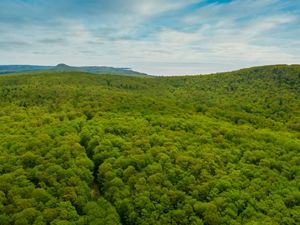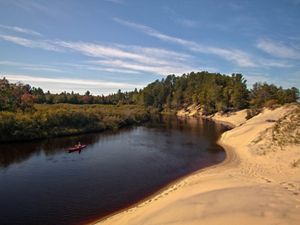Keweenaw Heartlands a Critical Stopover for Migrating Raptors.
Annual spring bird migration underscores importance of protecting the 32,000 acres of land.
Media Contacts
-
Ryan Hermes
TNC
Phone: 517-999-7745
Email: ryan.hermes@tnc.org
KEWEENAW COUNTY, Mich. — Many Michiganders are familiar with the influx of brightly colored birds of all shapes and sizes that congregate at birdfeeders and the marshy coastlines of the Great Lakes during the spring, looking for spots to rest and refuel as they migrate north. However, it's the rocky cliffs of the Keweenaw Peninsula that provide a critical resting spot for thousands of raptors—birds like eagles, hawks, and owls—as they rest up to make the final push across Lake Superior.
“Much like a family seeks a rest stop to rest and stretch on a road trip, these raptors stop to refuel and rest on the tip of the Keweenaw Peninsula before beginning the daunting journey across Lake Superior,” said Patrick Doran, Ph.D., Midwest director of The Nature Conservancy’s Strategy, Measures and Science Program. “On any given day this spring you can see more than a thousand raptors soaring along the spine of the Keweenaw Peninsula, representing over half of the different species of raptors that exist in North America. It’s an incredible sight to see.”
Jutting into Lake Superior, the Keweenaw Peninsula’s globally unique geology offer cliffs and bald granitic outcroppings—at just the right elevation—that appeal to migrating raptors. It’s a vital launching point for the likes of hawks, eagles and vultures looking to take advantage of the winds that will help carry them over the world’s largest freshwater lake.
“The Keweenaw Heartlands provide a vital migratory and nesting habitat for over 300 bird species, which is one of the countless reasons The Nature Conservancy purchased the land to ensure its protected and sustainably managed so both people and nature can thrive,” said Helen Taylor, state director of The Nature Conservancy in Michigan. “The spring migration of raptors is an extraordinary event and there’s no better place than the Keweenaw Heartlands to see these majestic birds before they make their final push across Lake Superior.”
The Nature Conservancy (TNC) purchased the Keweenaw Heartlands, which includes more than 32,000 acres of land, in two separate sales, one closing in late October 2022 and the second just before Christmas 2022.
The Keweenaw Heartlands are recognized by TNC as a global priority for both biodiversity and climate resiliency, and TNC’s Keweenaw Heartlands Project offers a shared opportunity to protect an extraordinary region, as well as the quality of life and economic benefits it provides to Keweenaw County residents and visitors.
While in TNC ownership, the land remains open to the public under the Michigan Commercial Forest Program and on community tax rolls. TNC, as the temporary owner before these lands are in public ownership, is working closely with the region’s communities to plan for the future of the Heartlands and ensure long-term protection of this forest for raptors and other wildlife.
TNC’s Bete Grise Wetlands Preserve, Helmut and Candis Stern Preserve at Mt. Baldy and Mary Macdonald Preserve at Horseshoe Harbor also provide important nesting grounds for migrating birds and opportunities to view them. Meanwhile, further south, Wilderness Lakes Reserve, with its dense forest and calm lakes, caters to loons and a myriad of species of songbirds.
The Nature Conservancy is a global conservation organization dedicated to conserving the lands and waters on which all life depends. Guided by science, we create innovative, on-the-ground solutions to our world’s toughest challenges so that nature and people can thrive together. We are tackling climate change, conserving lands, waters and oceans at an unprecedented scale, providing food and water sustainably and helping make cities more sustainable. The Nature Conservancy is working to make a lasting difference around the world in 81 countries and territories (40 by direct conservation impact and 41 through partners) through a collaborative approach that engages local communities, governments, the private sector, and other partners. To learn more, visit nature.org or follow @nature_press on X.



